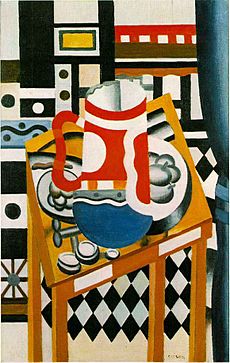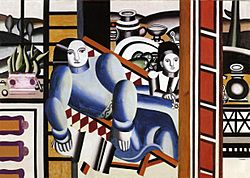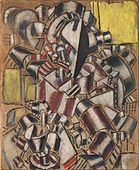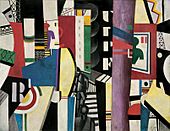Fernand Léger facts for kids
Quick facts for kids
Fernand Léger
|
|
|---|---|

Fernand Léger, c. 1916
|
|
| Born | February 4, 1881 |
| Died | August 17, 1955 (aged 74) Gif-sur-Yvette, France
|
| Known for | Painting, printmaking and filmmaking |
| Movement | Cubism Modernism |
Joseph Fernand Henri Léger (February 4, 1881 – August 17, 1955) was a French painter, sculptor, and filmmaker. He started with a unique style of cubism, which is an art movement where objects are broken up and reassembled in abstract forms. He later changed his style to be more realistic and focused on everyday life.
Léger's bold and simple way of showing modern things made him a pioneer of pop art. Pop art is an art movement that uses images from popular culture, like advertisements and comic books.
Contents
Fernand Léger's Life and Art
Léger was born in Argentan, France, where his father raised cattle. He first studied to be an architect from 1897 to 1899. In 1900, he moved to Paris and worked as an architectural draftsman.
After serving in the army, he tried to get into a famous art school but was rejected. However, he still attended classes there. He also studied at another art school called the Académie Julian. Léger began painting seriously when he was 25 years old. His early paintings showed the influence of impressionism, which uses small, thin brushstrokes to capture light.
Becoming a Cubist Artist
In 1907, Léger saw an exhibition of Paul Cézanne's work. Cézanne was a painter who used geometric shapes in his art. This inspired Léger to focus more on drawing and geometry in his own paintings.
In 1909, Léger moved to Montparnasse in Paris. There, he met many other artists, including Marc Chagall and Robert Delaunay.
In 1911, Léger and other artists who were called 'Cubists' showed their work together. This was the first time the public saw Cubism as an organized art group.
Léger's paintings from 1909 to 1914 became more abstract. He used tubular, cone-shaped, and cubed forms. He painted them in simple patches of primary colors (red, yellow, blue) along with green, black, and white. His series of paintings called Contrasting Forms shows this style.
War and Machines
Léger's experiences in World War I greatly affected his art. He served in the French Army from 1914 to 1916. While in the trenches, he drew many sketches of weapons, airplanes, and soldiers. He painted Soldier with a Pipe in 1916.
In 1916, he was injured by a mustard gas attack. While recovering, he painted The Card Players (1917). This painting shows robot-like figures, reflecting his war experiences. This work started his "mechanical period." During this time, his figures and objects looked smooth and machine-like.
Art in the 1920s
In the 1920s, Léger's "mechanical" works became clearer and more organized. They often showed mothers and children or figures in peaceful landscapes. This style connected him to older French painting traditions.
He also admired the artist Henri Rousseau, who painted in a simple, folk-like style. Léger's paintings from this time often had clear outlines and smooth colors, similar to Rousseau's work.
Léger was very interested in movies. For a while, he even thought about stopping painting to make films. In 1924, he helped create and direct an important film called Ballet Mécanique (Mechanical Ballet). This film showed close-ups of a woman's lips, everyday objects, and machines moving in a rhythm.
He also helped start an art school called the Académie Moderne. There, he taught from 1924 onwards. In 1925, he created his first "mural paintings." These were meant to be part of buildings and featured flat areas of color.
Changes in the 1930s
After 1927, Léger's art slowly changed. He started using more natural and irregular shapes. His style in the 1930s can be seen in paintings like Two Sisters (1935) and different versions of Adam and Eve. He sometimes showed Adam in a funny way, like wearing a striped bathing suit.
In 1931, Léger visited the United States for the first time. He went to New York City and Chicago. In 1935, the Museum of Modern Art in New York held an exhibition of his work.
World War II and Beyond
During World War II, Léger lived in the United States. He taught at Yale University. He found new ideas for his paintings by looking at industrial waste in the landscape. He was amazed by how natural forms and machine parts could be seen together. He called this the "law of contrast." This idea led to works like The Tree in the Ladder (1943–44).
While in America, Léger began painting with colorful bands of color placed next to figures outlined in black. He said the neon lights of New York City inspired this new style. He noticed how people's faces would suddenly turn blue, red, or yellow from the flashing lights.
When he returned to France in 1945, he joined the Communist Party. During this time, his art became less abstract. He created many large paintings showing scenes of everyday life. These included acrobats, builders, divers, and people enjoying country outings. Léger wanted to show common people and create art for them. He was a passionate humanist, meaning he cared deeply about human welfare. He also worked on book illustrations, murals, stained-glass windows, and costume designs.
Later Years and Legacy

After his first wife died in 1950, Léger married Nadia Khodossevitch in 1952. In his final years, he gave lectures and designed mosaics and stained-glass windows for the Central University of Venezuela in Caracas, Venezuela. He also painted the series The Big Parade. Fernand Léger died in 1955.
Léger believed that objects in modern painting should be the main focus. He thought that if the human form was treated like an object, artists could have more freedom. He said that abstract art helped artists see the human figure as a shape, not just for its feelings. Because he was one of the first painters to use images from the machine age and consumer society, he is seen as a founder of Pop Art.
He taught art for many years at different schools, including his own Académie Fernand Léger. Many artists studied with him.
In 1952, two of Léger's murals were placed in the United Nations General Assembly Hall in New York City. In 1960, the Fernand Léger Museum opened in France.
One of Léger's paintings, Étude pour la femme en bleu (1912–13), sold for over $39 million in 2008. In the same year, a painting called Mother and Child went missing from a college museum. A reward is offered for its safe return.
Gallery
See also
 In Spanish: Fernand Léger para niños
In Spanish: Fernand Léger para niños



















